Japanese Robots
Japanese Robots

Japanese Robots. When American robotics company, iRobot, introduced the Roomba in 2002, no one could tell it was a robot until it started moving. It was essentially one—it behaved autonomously, sucking up dirt and dust off every square inch of a floor on its own—but it lacked the one ingredient vital to most robot fans: a personality.
For Americans, the idea of giving an object a mind of its own has always been considered a little ominous, even kind of creepy. This is a sentiment that can probably be attributed to the country’s Judeo-Christian roots, which may have implanted the notion that giving “life” to a machine is essentially playing God.
The most popular Western robot films including Terminator, Blade Runner, and the Matrix have presented the “intelligent machines will rebel” premise many times and almost never presenting the robot as a hero.
Click HERE to see Honda's Japanese Robots
In Japan however, Japanese robot villains would only makes sense if there was a Japanese robot hero—one not necessarily stronger, but one with more heart. As the most robotized nation in the world, machine paranoia in the Japanese is rare, if not non-existent. Certainly, if harmonious human-robot coexistence was to happen anytime soon, no nation is more ready for it than Japan.
Many experts believe that Japan’s love affair with robots has its roots in their Shinto religion, where boundaries between the inanimate and animate are blurred. Followers therefore believe that everything, including objects, can possess living spirits. Jennifer Robertson, an anthropology professor at the University of Michigan says, “Robots have a long and friendly history in Japan, and humanoid robots are considered to be living things and even desirable members of families.”
A technology analyst at Macquarie Securities in Tokyo, Damien Thong adds that Japan sees robots as a force for good, unlike the west which views robots as a threat to human security and perhaps even their dominion over the world.
Today, Japan employs over a quarter of a million industrial robot workers, and the government hopes to have 1 million of these Japanese robots installed throughout the country by 2025. With an aging population and a continuously declining workforce, the country is banking on robots to fill this need since a single robot can allegedly replace about 10 human employees.
Already an industrial robot powerhouse, Japan has successfully developed industrial robots like Fuji Yusoki Kogyo’s Fuji Ace, a palletizing robot and Tsuyoshi-Kun, a robot designed to pack beverages bottles, canned and fresh food into cardboard boxes. Denso, a robot design pioneer, supplies four, five and six-axis high-speed, high-precision robots for payloads up to 20 Kg.
Nidec Sankyo has clean room-type handling robots, clean room wafer-handling robots and vacuum-environment robots and Yaskawa Electric has Motoman, the welding robot, among several other companies active in both the manufacturing distributing and employing of industrial robots in Japan and in other parts of the world.
In the past several years, tens of millions of dollars have gone into Japan’s robotic industry, whose revenues are predicted surge to $70 billion by 2025. And every couple of years, the country comes out with new Japanese robots that are more amazing, more life-like, or more accurate than the last. Not surprising for a nation whose love for robots has been practically ingrained in their culture, playing a dominant theme in Japanese manga, anime and video games.
Robot manga became influential as early as 1956, when Mitsuteru Yokoyama created the series Iron Man 28. This was adapted into a television series called Tetsujin 28-go, and later exported to the U.S. as Gigantor. Go Nagai’s Mazinger Z, which came out in in manga and anime in 1972, was also highly popular. Voltron: Defender of the Universe also originated from Japan’s Beast King GoLion, a Japanese super robot anime television series. Other well-loved robot-themed manga and anime titles include Evangelion, the more recent Tengen Toppa Gurren Lagann, and of course, Osamu Tezuka’s Astroboy.
Owing to Japan’s extreme passion and skill in robotics, some very unforgettable Japanese robots have rolled off their research facilities over the years. There’s Sony's Aibo, a robotic pet that over time, develops its own distinct personality; the “Child-Robot with Biomimetic Body” designed to mimic the motions of a toddler; RIBA, short for Robot for Interactive Body Assistance, a care support robot programmed to safely carry disabled or elderly persons weighing up to about 61kg.
There’s Honda’s ASIMO a humanoid robot designed to interact with humans and help facilitate their everyday lives, and more amazingly still, the HRP-4C, another robotic humanoid female who can sing or walk a model’s runway, depending on the type of model. Osaka University and Kokoro Company Ltd. continue to develop and improve a humanoid robot they call an actroid, designed with extremely strong visual human-likeness.
Fortunately, no instances of robot rebellion have been reported so far.